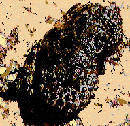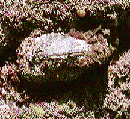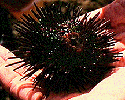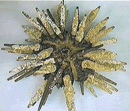| |
Lab Activity 9.2
Biota 4: Organisms Found
in Beachrock Crevices
|
|
|
|
Directions
|
|

|
Study
the instructional material below. Be sure to click on each of the photographs
for an enlarged view in a separate window. The
larger version is necessary to complete the assignment.
It opens in a separate window which can be resized by grabbing the bottom
right corner and dragging it. It
can also be moved by
grabbing the top heading bar and dragging it.
Be sure to close the extra window by using the X in IBM, or the close box
in MAC when you are finished using them. |
|
|
Introduction
|
|

|
In
this activity you will study the organisms of beachrock crevices. |
|
 Instruction
Instruction
|
|

|
Use
the information below to fill out the checklist of the biota of beachrock
microhabitats.
Be sure
to write about what you are learning in the lab section of your notebook.
You will be expected to answer questions about the lab activity during
the lab self test and lab quiz. It helps to have your text and coloring
books open beside you for support.
|
| |
| Supporting
Information |
| Refer
to the Assigned Readings Below: |
| Marine
Biology Textbook |
none |
| Marine
Biology Coloring Book |
none |
|
| |
|
This
picture gallery summarizes the biota found in beachrock crevices at Playa
Estacion, Puerto Penasco, Sonora, Mexico.
It should
be used to complete lab activity 9.2.
|
Eriphia
squamata
|
 |
"Lumpy-clawed
Crab"
| Phylum |
Arthropoda |
| Class |
Crustacea |
| Order |
Decapoda |
| Family |
Xanthidae |
|
| Morphology |
Its
body (carapace) is usually 1-2 inches wide. It is mottled gray
to green and its legs are banded with black. |
| Feeding |
Feeds at night.
Forages for worms, algae and smaller crabs. |
| Defense |
Large claws
that can pinch. Will defend its territory savagely. Hides during
the day in holes or crevices. |
| Reproduction |
Males pass spermatophores
to females during copulation. Females carry fertilized eggs
under abdomenal flap. Hatchlings are zoea larvae that develop
in the plankton. |
| Habitat |
Occurs in great
numbers in the lower midintertidal zone of rocky shores. |
| Distribution |
Ranges from
upper Gulf to Ecquador and Galapagos Islands. |
| Other |
One of the most
common crabs - very territorial. |
|
|
Modiolus
capax
|
 |
"Horse
Mussel"
| Phylum |
Mollusca |
| Class |
Pelecypoda |
| Order |
Mytiloidea |
| Family |
Mytilidae |
|
| Morphology |
A
swollen orange-brown shell covered with a "beard"
of serrated brown hairs distinguishes this mussel from any other.
The shell lacks any strong sculpture. |
| Feeding |
Filter feeders. |
| Defense |
The serrated
hairs provide camoflouge for the mussel as well as a place for
other animals to grow. Can close its shell to conseve moisture
- may also tightly close shell if disturbed. |
| Reproduction |
Separate sexes
and spawning. |
| Habitat |
Intertidally
on rocky substrate. |
| Distribution |
Northern California
to Peru and throughout the Gulf of California. |
| Other |
|
|
|
Echinometra
vanbrunti
|
 |
"Purple
sea urchin"
| Phylum |
Echinodermata |
| Class |
Echinoidea |
| Order |
Camarodonta |
| Family |
Echinometridae |
|
| Morphology |
A
dark purple urchin with long (one inch) slender spines. |
| Feeding |
Graze on algae |
| Defense |
The brittle
spines may break off and cause puncture wounds that are very
painful. |
| Reproduction |
Separate sexes
and synchronous spawning |
| Habitat |
Intertidally
on rocky substrate.Particularly in crevices and cavities in
rocks and reefs, where it can avoid the full impact of the surf. |
| Distribution |
Northern Gulf
of California to Peru and Galapagos Islands. |
| Other |
|
|
|
Eucidaris
thouarsii
|
 |
"Slate
pencil urchin"
| Phylum |
Ecinodermata |
| Class |
Echinoidea |
| Order |
Cidaroidea |
| Family |
Cidaridae |
|
| Morphology |
A
brownish purple urchin with a test diameter of up to 3 inches
and ten vertical rows of five to eight thick spines which taper
to a blunt tip. Spines often encrusted with bryozoans and sponges. |
| Feeding |
Grazing on algae
and encrusting invertebrates |
| Defense |
Can wedge itself
into crevices using its spines |
| Reproduction |
Separate sexes
and synchronous spawning |
| Habitat |
Crevices and
cavities in rocks on reefs in the lower intertidal and subtidal |
| Distribution |
Gulf of California
south to Ecuador |
| Other |
|
|
|
|
|
|
|
|
|
|
|



